Step Up the Fight for Rights
• Jobs Are a Right!
• Indianapolis GM Workers Militantly Oppose Secret Deals, Blackmail and Concessions
• To Our Local 23 UAW Sisters and Brothers
• Four Million More People Living in Poverty
• Jobless Rate Causes Deep Concern
• August Report on the U.S. Capitalist Labor Market
Working people across the country are deeply concerned about growing unemployment and poverty. There is increasing anger with the fact that the wealth produced by the workers is not utilized to serve their interests and the interests of society as a whole, beginning with guaranteeing the rights of all. Instead it is utilized against fellow workers abroad, in aggressive wars like those against the peoples of Iraq and Afghanistan. The U.S. war machine continues to take trillions in public funds, with yearly Pentagon funding alone now more than $700 billion.
But ending war funding is not put on the agenda as one means to improve the economy. Instead it is said that workers’ wages and benefits are the source of problems for the monopolies, and “tough decisions” must be made. The blackmail of plant closures is used to demand wage cuts of 50 percent and elimination or big cuts of pensions, either for retirees or for new hires.
Living in one of the richest countries in the world, knowing that abundant wealth has been produced by the workers, yet everywhere people face more poverty, unemployment and war, consideration is being given to the necessity for an alternative. History is calling on the working class to come forward and build a new society, one constituted by the working class, for the working class and all humanity. One where jobs, housing, healthcare, education, secure retirement are rights, not an “opportunity,” given and taken away as the monopolies decide.
In an effort to block this striving for a new society, the ruling class is attempting to say workers and capitalists are one, and have common aims and values. Speaking on Labor Day in Milwaukee, President Barack Obama put forward as an aim to “renew the American Dream, not just for your family, not just for all our families, but for future generations.” He added, “the chance for everybody, no matter how humble their beginnings, to join that middle class — a middle class built on the idea that if you work hard, if you live up to your responsibilities, then you can get ahead; that you can enjoy some basic guarantees in life. A good job that pays a good wage. Health care that will be there when you get sick. A secure retirement even if you’re not rich. An education that will give your children a better life than we had. These are simple ideas. These are American ideas. These are union ideas. That’s what we’re fighting for.” He continued, “There are no better workers than American workers. I’ll put my money on you any day of the week. And when the naysayers said, well, you can’t save the auto industry, just go ahead and let hundreds of thousands of jobs vanish, we said we’re going to stand by those workers. If the management is willing to make tough choices, if everybody is willing to come together, I’m confident that the American auto industry can compete once again.”
Obama is putting forward the “American Dream,” which at best provided an “opportunity” to “get ahead,” as the best that American workers can achieve. This is a very tired and old “dream,” well known as a nightmare for millions. How can that be the solution for the problems of the present, including problems of war and impoverishment? The entire history of the country shows that there has been no time that jobs, healthcare, a secure retirement, and education have been guaranteed as rights.
Obama is also doing so at a time when even the possibility of this “American Dream,” stemming in part on the social contract that emerged after World War Two, no longer exists. Contracts have been rendered meaningless. Secure jobs are non-existent, pensions are being eliminated and wages slashed, and yet more concessions demanded. This is the reality. And to hammer that home, Obama uses the example of the auto industry, where “If everybody is willing to come together the American auto industry can compete once again.” The demand is for workers to accept yet more concessions — which is and has been the content of “working together.”
In the face of the massive wrecking of the auto industry and manufacturing as a whole, why should workers “come together” to serve the needs of the monopolies to be competitive on the global market? Why not discuss and consciously fight for a real alternative, of serving the interests of the workers and society as a whole? Why not a society where the rights of all are guaranteed, and these rights are written in the Constitution and enabling legislation guarantees them and makes failure to provide them crimes? Why not a society where the workers constitute the nation and where the people themselves are empowered to decide, not the rich!
American workers have a social responsibility, to themselves as a class, and to workers worldwide, to break with the demand of the U.S. ruling class to work together for the benefit of the monopolies. This is especially true in these dangerous times, when the U.S. rulers are attempting to subvert resistance and line American workers up for more war against their fellow workers abroad. Let all stand together to say NO! Let all reject unity with the rulers and join in discussing and elaborating a new society modeled after the working class, its stand for the rights of all and for the fraternal unity of the peoples. Let all grab hold of the necessity for an alternative!
October 2: Workers Rally in Washington, DC , for Jobs, Justice and Peace


![]()
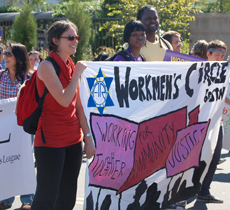

![]()
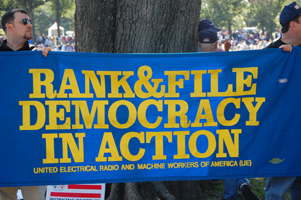
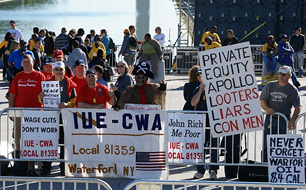
![]()


![]()

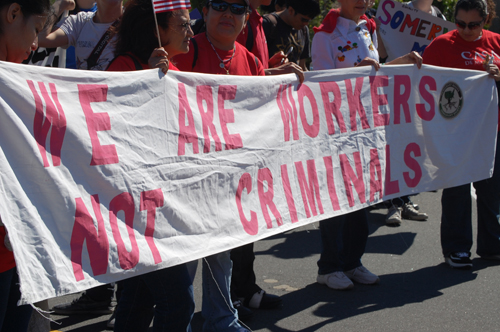
![]()

![]()
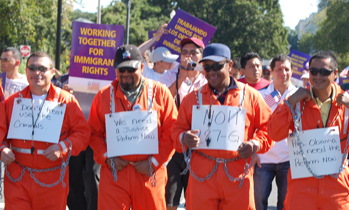

![]()

![]()

![]()


![]()
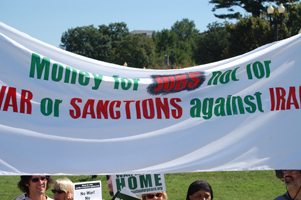

[TOP]
Indianapolis GM Workers Militantly Oppose Secret Deals, Blackmail and Concessions
On August 15, the workers at a GM stamping plant in Indianapolis militantly opposed the secret deals and blackmail being used to impose anti-labor concessions on them. GM announced more than a year ago that it planned to close the plant and is looking for a new buyer. The closure is part of the “new GM” which is being built with the full backing of the Obama administration and its $50 billion bailout and the fraudulent bankruptcy protection from which GM emerged in July 2009. Closures of plants, massive elimination of jobs, forced concessions, secret deals and blackmail are part of this "new GM" that the workers are opposing.
In April, GM announced that it found a potential buyer, JD Norman Industries of Chicago. JD Norman said it would buy the plant only if the workers agreed to reopen their collective agreement and take a 50 percent cut in wages across the board. GM claimed this was the only chance the workers had to keep the plant open otherwise it says it will close the facility by mid-2011.
At a membership meeting in May the workers affirmed their adamant refusal to make concessions by a vote of 384-22. Despite this, regional UAW representatives went against the expressed will of the workers and engaged in secret talks with the potential buyer. Meanwhile, GM continued to pressure the workers to reopen the contract and agree to the concessions in exchange for a promise that GM would rehire them later on at full UAW wages if they agreed to temporarily work for JD Norman at half their current wages. The UAW regional reps filled the pages of the monopoly media with threats that this was the last chance for the workers to keep the plant, that GM was "pulling out of Indianapolis," the monopoly would proceed with the dismantling of the plant before 2011, etc.
UAW regional reps and the president of the local, bypassing the local’s executive committee, convened workers to the August 15 “information meeting”. The stated purpose of the meeting was to provide "highlights" of an agreement reached in secret by UAW regional and the potential buyer, which was to be followed by a vote on the agreement on the following day, August 16. Those who convened the meeting forbade the participation of the workers' spouses, in contravention of the norms of the local.
Despite the attempt to ambush them, workers filled the meeting hall in numbers, many of them wearing T-shirts reading "Honor the Contract!" As the UAW regional representatives tried to start the meeting and present their so-called information on the secret agreement, they were met by shouts of "This meeting is illegal!"; "Respect the contract!"; "This is our hall!" and more. When one of the conveners finally asked if any worker wanted to hear the information, he was met by a thunderous "No!" The three UAW regional reps and the president of the local had to leave the hall.
Outside of the hall, workers expressed to the media their rejection of the blackmail for concessions, saying that their will must be respected by all. They pointed out that agreeing to cutbacks of 50 percent in their wages would send the signal to the monopolies that working conditions of stamping plant workers across the U.S. were up for grabs and could be destroyed to the point where workers cannot even make a living. Some said that there is a provision in their contract that allows them to move to other GM locations with their same current working conditions if their plant closes and they said that this atmosphere of panic and blackmail prevents even discussing what the options are for the workers.
While the workers expressed pride in their just stand and are discussing ways to step their struggle, GM, the potential buyer and some high ranking leaders of UAW are now urging the workers to "reconsider" and are shamelessly blaming the workers for putting the last nail in their own coffin by allegedly shutting down the plant themselves.
Despite the pressure from GM and top UAW leaders, on September 27 the Local 23 workers stood firm in rejecting concessions, voting 457-96 against the GM proposal. It is reported that JD Norman has now withdrawn their offer. This leaves open the possibility for the workers, together with the city and state, to take over the plant and run it as a publicly run factory with production meeting the needs of the local and regional area.
[TOP]
To Our Local 23 UAW Sisters and Brothers
Greetings and Solidarity,
We are writing to express our deep respect and admiration for your acts of solidarity and courage in the face of tremendous pressure. We applaud Local 23’s bargaining chair and committee for their strength. [Local 23 is the local union at GM’s Indianapolis stamping plant — VOR Ed.]
As former (and current) Local Union Presidents, Shop Chairs and other elected representatives, we have witnessed the incessant drumbeat for concession after concession. None of us have ever thought that concessions were the answer to the problems faced by the auto industry, or any industry for that matter…
Workers and their unions struggled throughout the 1900’s to raise the standard of living for working people – to create a comfortable life for themselves and their children. We fought for our fair share of the pie and thereby created the “American Dream” – a life where people were permitted vacations, health care and safe jobs. These jobs helped bring about a “middle class” existence for working people and the ability to send our kids to college. Before the union movement, workers did not have respect and dignity on the job or a decent standard of living. Children of workers rarely went to college. We earned these things through struggle.
Still, workers have given up pay and benefits over the last 20+ years, in an effort to try and help their employers. But it has never been enough. Now we see everything we struggled for being taken away. The “Dream” is being dismantled before our very eyes. But where is the “equality of sacrifice”?
If the situation is so dire, why aren’t those in power leading by example? Are GM execs willing to take a 50 percent pay cut? Is JD Norman saying he and his managers will take a 50 percent cut in pay if they buy the plant? The answer is obvious to us. No, they are not. They want you to. What we have seen in the last 40 years is a growing disparity between the rich and the rest of us. Those at the top cannot continue to get wealthier unless the rest of us give up more. And that is what they want us to do.
That is why we stand in solidarity with you in this struggle. A line must be drawn. If you give in, it will be used to whipsaw other plants especially GM Stamping Plants into taking equal or greater concessions. Suppliers and other businesses will pressure their employees to take cuts in the never-ending ”race to the bottom.” If you stand strong, it will help everyone.
It appears to us that you have made your wishes clear. In our democratic union, the wishes of the majority must be respected. You have our deepest respect.
In Solidarity,
Jerry Tucker, Former UAW Region 5 Director
Tom Laney, Retired former President & Floor Rep. Local 879, St. Paul
Bruce Allen, Vice-President, Canadian Autoworkers Local 199, St. Catharines, Ontario
Gary Walkowicz Local 600 Truck Plant Bargaining Committee
Vern Hetz Local 2093 retired Bargaining Rep. Three Rivers, MI
Charles W. Maynard, Vice-President of Local 686, Lockport, New York
Pam Gmyr, UAW Local 465, Union Representative, Massena NY
Victor Bean, Former Local 600 General Council Delegate
Al Benchich Convention Delegate, Retired Former President, L. 909, UAW
Dean Braid, former Education Director, UAW Local 599, Buick City, Flint
Jeff Brown, former Suggestions Rep, Local 3000
Ali Canada, former Bargaining Committee Member, UAW Local 849
Mandy Cohen, Head Steward UAW 2865, Academic Student Employees of the University of California
Mark Farris, former Unit Vice President and Convention Delegate, L. 600. Milan Plastics
Yvonne Gomillion, retired former EAP Rep., Local 909 and mother of Local 23 member Roy Gomillion
Martha Grevatt, former Trustee and Civil Rights Chair, UAW Local 122, Twinsburg, Ohio
Ernie Hite, former district committeeperson and convention delegate UAW Local 663.
Jeff Hodges UAW Convention Delegate L. 3000 and former shop committeeperson
Ron Lare, former Local 600 Exec Bd Member
Allen Sonny Myers, former UAW Local 849 Trustee and Guide
Herman Rosenfeld, Local 303, GM Scarborough Van Plant, Scarborough, Ontario, Canada
Jessica Taal, Unit Chair, UC Berkeley, Local 2865.
Wendy Thompson, Convention Alt., L. 22, UAW, Retired Former President, L. 235, UAW, American Axle, Detroit Gear & Axle
Bob Weissman, former President, Chrysler Stamping Local 122, Twinsburg, Ohio
Judy Wraight, former Local 600 General Council Delegate
Dick Danjin, Union Representative 1971 through 1998 (retired)
Frank Hammer, retired UAW Int’l Rep., former Pres. & Chair, GM Powertrain Local 909, Detroit
Joseph Gaw, former President UAW Local 499, member of Locals 371, 2075, 287, 499,and 23
Barbara Julien, UAW Local 292, former Trustee and Executive Board Member
Douglas Wells, UAW Local 2164, former member Local 1097
Roger Long, former UAW representative Local 2031
Eli Friedman, UAW Local 2865, representing Academic Student Employees at the University of California Ph.D. Candidate, Department of Sociology, University of California, Berkeley
Steven Schwab, Executive Board Member, UAW Local 699
Cassandra Calvert Local Union 2209 Past Financial Secretary
Lindsay Hinshelwood, CAW Local 707, candidate for Vice President, CAW-Ford Oakville, Ontario Assembly Plant
Al Gardner, former Chairman of the Tool & Die Unit, Local 600 UAW from 1978 to 1988
Erwin Baur, former UAW Local 160 President
Pete Kelly, former UAW 160 President
Larry Christensen, UAW-Chrysler Local 140, Chief Steward
Jan Dean, retired Local 2164
Marcus Hamilton, District Committeeperson, Local 5960, Lake Orion
Cathy Huff-Abney, District Committeeperson and Delegate, Dearborn Truck, L. 600
Bob Weinert, former Shop Committeeperson, Local 22
Tim England former Zone Committeeperson Local 2250
Mary Donovan Springowski, District Committeeperson, UAW Local 2000, Delegate to Constitutional Convention and Special Convention (e.g. Bargaining/Negotiations Convention)
Robert L. Morris Jr., Convention Delegate and Bargaining Committee Member, Parts Depots UAW Local 600
Elly Leary, former chief negotiator and vice-president of L. 2324, Boston U.
Ignacio Meneses UAW local 174 US Cuba Labor Exchange
Terry Wilcox Former District Committeeman Local 1853
[TOP]
Four Million More People Living in Poverty
The deepest recession in modern times has sharply increased the number of people, especially children, living in poverty. One in 7 people are officially counted as living in poverty, an estimated 43.6 million people. This is an increase of about 4 million, with the 2009 poverty level up to 14.3 percent, up from 13.2 percent in 2008. The jump brings the number of people impoverished to its highest level since 1959, five years before the Johnson-era “War on Poverty.” It is also the third consecutive year the poverty rate has increased.
The U.S. government considers an annual income of $21,756 to be the poverty line for a family of four. Given that this official poverty level underestimates the numbers of families living in poverty, the actual levels are even higher.
A U.S. Census Bureau report released September 16 underscores how deeply the Great Recession has affected the people’s standard of living. The key findings of report, which compared income, poverty rate, and health-care insurance coverage in 2009 with 2008 numbers, include the following.
1) Some 43.6 million people were living in poverty last year – the highest number in the last 50 years. The overall poverty rate was 14.3 percent, up from 13.2 percent in 2008 and the highest level since 1994. Among the working-age population, ages 18 to 65, poverty rose from 11.7 percent to 12.9 percent, the highest level since the 1960s. Hispanic households took the hardest hit: Their poverty rate rose 2.1 percent from 2008′s level, compared with a 1.1 percent jump in the rate for African Americans and whites.
2) A record number of Americans, 50.7 million, were not covered by health-care insurance in 2009. This is an increase of almost 4.5 million since 2008. The share of Americans without health coverage rose from 15.4 percent to 16.7 percent, mostly because of mass layoffs. At the time the survey was being taken, Congress passed President Obama’s health-care reform law. It remains to be seen if this will change the fact that increasing numbers of people do not have the healthcare they need and healthcare costs remain a main reason forcing families to file for bankruptcy.
New figures also show that home foreclosures for August hit the highest level since the mortgage crisis began. Banks repossessed 95,364 properties in August, up 3 percent from July and an increase of 25 percent from August 2009, according to RealtyTrac, a company that charts the national picture.
RealtyTrac sees a record 1.2 million repossessions this year, up from just under 1 million last year, with more than 3.2 million homes in some stage of foreclosure. In 2005, before the housing bust created by the Wall Street financiers, banks took over just about 100,000 houses.
Foreclosures rose in 3 of every four large U.S. metro areas in the first half of 2010. Foreclosure actions — which include notice of default, scheduled auction and repossession —rose in 154 of the 206 metro areas with populations 200,000 or more. Cities with the 20 highest foreclosure rates were all in Florida, California, Nevada and Arizona.
[TOP]
Jobless Rate Causes Deep Concern
Persistent high unemployment in the United States is causing pessimism and deep concern amongst unemployed and employed workers. Commentaries in the U.S. media give a gloomy picture of job prospects for the unemployed. They suggest that structural changes in the capitalist labor market point to a serious jobless recovery from the economic crisis. Just to stabilize the employed U.S. labor market of 139.25 million and the unemployed labor market of 14.86 million requires a two percent per year growth in the Gross Domestic Product (GDP). GDP is an approximate measurement of the total value of goods and services produced by workers during a specific period, usually one year. A one percent hike in GDP is needed to compensate for annual advances in productivity that shrink employment. One percent GDP growth would stabilize the employed labor market at its current number. Another one percent growth in GDP is needed to match the yearly demographic change in new members joining the labor market from either the birthrate or immigration. This one percent GDP expansion would stabilize the unemployed labor market at 14.86 million and allow the employed labor market to absorb the net increase from new members.
U.S. economists consider this two percent GDP growth non-recessionary or a non-crisis amount but it would do nothing to bring back to work the over six million jobs lost since the onset of the 2008 economic crisis not to speak of the additional millions more who are officially part of the jobless labor market.
The U.S. 2010 second quarter GDP annual rate of growth was 1.60 percent. This is not considered recessionary but is not enough to stop an expansion of the absolute number in the unemployed labor market let alone bring back to work those laid off during the crisis. This is bad news for both unemployed and employed workers. This jobless partial recovery from the economic crisis represents a structural failure of capitalism to meet the needs of the people.
[TOP]
August Report on the U.S.
Capitalist Labor Market
The August U.S. government survey shows that the percentage of unemployed workers within the capitalist labor market was 9.6 percent. This marks the 12th consecutive month that unemployed workers represent over 9.5 percent of the capitalist labor market. The number of unemployed workers in the labor market in August was 14.86 million and the number employed 139.25 million.
Among the major worker groups designated by the Labor Bureau, the unemployment rate for adult men was 9.8 percent, adult women (8.0 percent), teenagers (26.3 percent), whites (8.7 percent), blacks (16.3 percent), and Hispanics (12.0 percent). The jobless rate for U.S. members of the labor market of Asian descent was 7.2 percent.
(Please note that VOR does not endorse the obsolete racial categories "white," "black," "Hispanics," or "Asian." Workers are members of their proletarian class, residents of the United States and members of specific nationalities such as Mexican, Aboriginal Nation, Chinese etc., of African or specifically Nigerian descent etc., European or specifically Irish or English descent etc. or a combination of two or more nationalities.)
The number of long-term unemployed workers in the labor market (those jobless for 27 weeks and over) declined by 323,000 over the month to 6.2 million. In August, 42.0 percent of unemployed workers in the labor market had been jobless for 27 weeks or more.
The Bureau of Labor reports:
"[In August] the number of persons employed part time for economic reasons (sometimes referred to as involuntary part-time workers) increased by 331,000 over the month to 8.9 million. These individuals were working part time because their hours had been cut back or because they were unable to find a full-time job.
"About 2.4 million persons were marginally attached to the labor force in August, little changed from a year earlier. These individuals were not in the labor force, wanted and were available for work, and had looked for a job sometime in the prior 12 months. They were not counted as unemployed because they had not searched for work in the 4 weeks preceding the survey.
"Among the marginally attached, there were 1.1 million discouraged workers in August, an increase of 352,000 from a year earlier. Discouraged workers are persons not currently looking for work because they believe no jobs are available for them. The remaining 1.3 million persons marginally attached to the labor force had not searched for work in the 4 weeks preceding the survey for reasons such as school attendance or family responsibilities."
Non-government employment increased by 67,000 last month, which is far less than needed to keep up with gains in productivity and monthly additions to the work force. Some 139.3 million Americans had jobs in August, compared with 145.7 million on a seasonally adjusted basis in August 2007.
Last May, a record 46 percent of all U.S. residents officially unemployed and within the labor market had been out of work for more than six months. That is the highest level since the government started keeping track in 1948, and it is about double the percentage of long-term unemployed seen during the harsh economic crisis of the early 1980s.
For the decade ending in 2007, approximately 4 million jobs were lost in the U.S. manufacturing sector, whose share in total employment during that period fell from more than 17 percent to 12 percent.
California
Nearly 2.3 million Californians remain unemployed, and 980,000 of them have been looking for work for more than half a year. The long-term unemployed group is up nearly sevenfold from 143,600 counted in July of 2007, according to a report recently issued by the California Budget Project (CBP).
The San Bernardino County Department of Workforce Development reports that 70 percent of the long-term unemployed in the largest county in California have been without a job longer than a year. CBP says that in June 2010, for every job opening five unemployed sought to sell their labor power. "This means that for four out of five unemployed individuals, there are literally no jobs," the report states. Less than 10 percent of those unemployed for more than eight months found work in late 2009, according to the report.
The CBP report states that the large number of permanent layoffs, "reflect a structural decline in construction and financial activities due to the housing bust." Longer-term unemployment increases the possibility of workers falling into what the Labor Bureau calls "marginal membership in the labor force" or out of the labor market altogether.
Nationwide, more than 86 percent of workers who were laid off lost their job because their positions were permanently eliminated, the Labor Bureau July statistics show.
(Sources: U.S. Bureau of Labor Statistics; "U.S. jobless rate hints at permanent shift," Globe and Mail; "Elevated unemployment appears as the 'new' normal," STLtoday; "Structural adjustment poses challenges to U.S.," Gulf Times; "Long-haul unemployment — a reality for nearly half of job seekers," Inland Valley Daily Bulletin)
[TOP]
